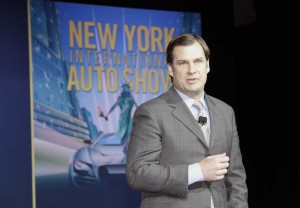If you’re like most motorists, you’ve struggled to reconcile the numbers in those endless automotive ads with the actual mileage you’re likely getting day-to-day.
The reality is that the current EPA fuel economy rating system doesn’t work, and American motorists are both “confused” and “tuning out,” according to Jim Farley, global marketing chief at Ford Motor Co. That’s especially true when it comes to hybrid vehicles, which can be extremely sensitive to variations such as weather, road conditions and personal driving style, he added.
So, a new way of calculating mileage that gives motorists a real idea of what to expect is necessary, said Farley, in his keynote speech at this year’s New York International Auto Show.
“It is confusing how we express fuel economy,” he declared, adding that the official federal ratings “really aren’t relevant. We need to help customers understand their personal fuel economy.”
Studies show that mileage is now top of mind for most American motorists, especially those shopping for a new vehicle. During his speech, Farley introduced a senior Facebook executive who said that the social media service has found that users discuss fuel economy 10 times more often than vehicle prices.
But much of that discussion has turned to the gap between rated and real-world mileage. Late last year, Hyundai and sibling Kia had to admit they fudged fuel economy tests and downgraded the mpg ratings on 13 models by as much as six miles per gallon. Ford, meanwhile, has taken a lot of criticism – and faces several lawsuits – over the window sticker ratings for some of its products, primarily hybrids like the C-Max and Fusion Hybrid.
The industry doesn’t help matters, Farley acknowledged, by putting an emphasis in advertising on a vehicle’s highest rating, typically the Highway number. Some critics contend that makers should voluntarily switch to only marketing the Combined City/Highway ratings, which tend to be closest to typical day-to-day performance.
Even then, said Farley, two different drivers could get wildly different results from the same vehicle. Operating in cold weather at high altitudes, for example, will sharply reduce fuel economy. And a lead-footed driver will see relatively limited benefits from a hybrid, especially compared with “hyper-milers” who closely watch the “eco-gauges’ found on most gas-electric models to help minimize consumption.
Ford has been “experimenting” with ways to promote its mileage without necessarily using the government’s official numbers, according to Farley. Meanwhile, it is “working with the EPA” to find a way to deliver more valid numbers, Farley hinted, though he did not offer specific ideas under discussion.
During his speech, meanwhile, the executive announced the “Personalized Fuel-Efficiency App Challenge,” a contest aimed at both hardware and software developers encouraging them to assist in the search for ways to give more real-world mileage guidance to consumers.
The contest carries with it a $50,000 prize.
If it generates a serious alternative to the current approach, said Farley, “it could dramatically change how customers drive.”


The problem is complex and it will be very difficult to come up with one system that can determine a realistic mpg for the various car/truck models due to a variety of reasons. Even if you can develop a better system than the current system, history has shown that driving habits can change the real world mpg as much as 30%. That doesn’t include extreme usage such as red light street racing.
So if a car has an EPA 20 mpg rating someone who drives poorly might only get 14 mpg, in which case they will claim the EPA rating is outlandish, when in fact it really is not. There in lies the problem and the reason why an EPA standardized mpg test was developed many years ago. The EPA mpg test cycle has been tweeked in recent years to try and be more representative, but I know of no accurate means to do much better than the current EPA mpg test for chemical fuel powered vehicles.
Hybrid vehicles are going to be a nightmare to obtain accurate mpg rating because they are constantly changing modes depending on the technology, driver and driving conditions.